
Most home service business owners see local directory websites as a way to get leads.
As much as Yelp, Houzz, Google My Business, HomeAdvisor, and others are solid drivers for lead generation, that isn’t the complete picture of what you stand to gain from getting listed on these sites.
In this article, we’ll show you unique strategies to become a power user of local directories and attract tremendous benefits for your business.
You’ll learn how to:
- Use your positive reviews to understand your customers better and find your unique value proposition to launch more successful marketing campaigns.
- Mine your competitors’ reviews for valuable insights, and always keep your business one step ahead.
- Take advantage of free local directories’ backlinks to rank your website higher on Google.
Leveraging Local Directory Sites to Rank Higher on Google
Optimizing your business website for search engines is a great strategy to improve the traffic you get.
But if you’re looking to generate leads at a much faster pace, you need to understand that Google will always favor local directory sites over individual company websites for the high-traffic keywords like “HVAC companies”.
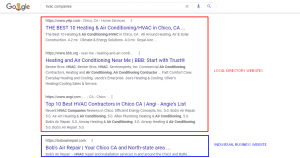
It is only after the ads, Google Maps listings, and the “people also ask” box, that you’ll begin to see organic results. And online directories top these organic results.
This is because of user intent.
According to Searchmetrics:
“The user intent, or search intent, states which goal or intention an internet user has when entering a search term into a search engine. User intent is now a central factor in content and search engine optimization and is eclipsing individual keywords as a dominant ranking factor.”
Google knows these searches in plural keywords, and people are looking for options to compare and choose from. And that’s what local directory sites give them.
You cannot rank for some keywords with your website alone.
That’s why you should get listed on local directories and use long-tail keywords in your business descriptions.
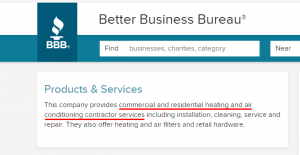
An example of a long-tail keyword in products and services description on BBB
Long-tail keywords are longer and more specific than regular keywords. People use it when they’re close to making a purchase or using voice search.
These kinds of keywords have high commercial intent. That means people who use them are more likely to become customers.
How do you find long-tail keywords relevant to your home service business?
- Use Google Keyword Planner: Google has a feature on Google Ads expert mode that suggests keywords you can rank for. That’s the Google Keyword Planner. You can access it by logging in to your Google Ads account, click Tools > Planning > Keyword Planner.
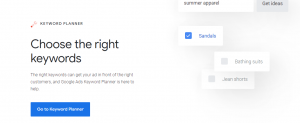
- Use Google’s Autocomplete feature: When searching on Google, extra words are suggested to complete your query.
It was designed to make the search more specific. But you can use it to find long-tail keywords since they base this on what people usually search for.
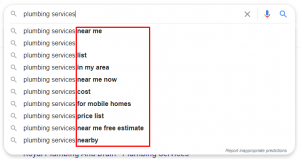
- Use a free SEO tool: SEO tools like Ubersuggest, Moz, and Ahrefs have a free keyword research tool that you can use to explore a broad range of longer related keywords.
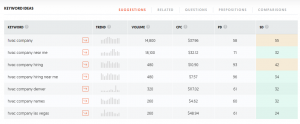
So, to take advantage of the SEO strengths of local directory sites, your first thing to do is get listed. Then, fill out your company information. When describing your business, use long-tail keywords relevant to your services to rank for them.
Find out what local directories to prioritize for your business and local area.
Not all local directories will rank on the first page of Google for a certain keyword at a time.
When we searched for “HVAC companies” on Google, only Google My Business, Yelp, BBB, Angi, HomeAdvisor, and Houzz showed up on the first page.
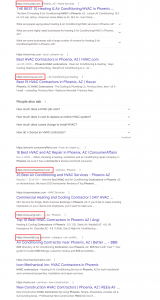
If you’re an HVAC company, you’d want to prioritize getting listed on these six sites first. And properly optimize your profile to rank on top.
You can start with a “simple name of service + local area” Google search and see what directories make it to the first page.
But that doesn’t mean you should disregard other directories. Some people prefer a certain site and will search on that website for contractors to work with.
For instance, even if Bingplaces doesn’t show up on the first page of Google, they have users who log on to Bingplaces and search there. You don’t want to miss those leads.
Reaping the low-hanging fruit of local directory backlinks
Another one of Google’s major ranking factors is backlinks. Backlinks are other sites pointing to your website with your URL. For example, the link to your website on your Yelp profile.
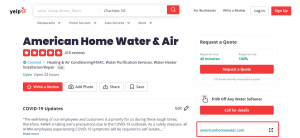
What this does is signify to Google that your website contains information worth checking out.
Now, not all backlinks are created equal. If a high authority site such as Yelp (DA: 93) links to your site, that packs more SEO substance than Angi (DA: 44) linking to you.
The standard practice in search engine optimization is to get your site listed on these sites immediately after it is launched.
It’s a tedious process. But you’ll be taking advantage of the easiest way to get sites linking back to you and up your rank on Google.
You can start with Google My Business (GMB).
When setting up your GMB listing, you will provide your business contact information, including your website URL.
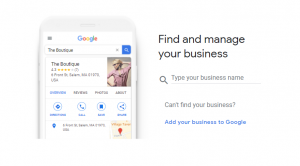
When this listing is verified, then your business will be featured on Google in a nice information box that users can easily use.
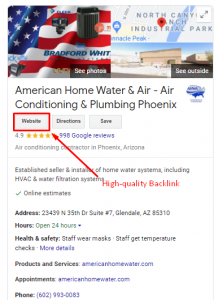
This will bring you more customers through Google searches without them passing through your site first. They can call you right from the search results page.
Also, this gives your website more credibility and shoots you further up the ranks on search engine results pages (SERPs).
It can get better. You can optimize your GMB listing by:
- Adding high-quality pictures of your business and what you do
- Let customers know when you’re open by inputting your business hours
- Add more phone numbers
- Add extra (but relevant) categories
- Keeping your listing up-to-date with content and updates
The category you select on GMB is incredibly important. It must represent what you want your business to show up for.
For example, if you’re in Phoenix, AZ, where people are more likely to search for “air conditioning systems” vs “air conditioning and heating”, you should select air conditioning contractor as your category on GMB.
But if you’re in an area providing both air conditioning and heating services, you should select the HVAC company category.
You can use this strategy with other sites like Houzz, Thumbtack, HomeAdvisor, Bark, Porch, and Pro Referral. They have a domain authority of around 70. And there are several more.
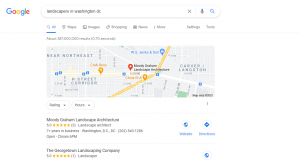
Optimizing your GMB listing and getting featured on Google Maps are two of the most potent local SEO strategies. For many search queries, Google features results from Google Maps at the top.
Leveraging Online Directories to Understand Your Competition Better
The information you gather from online directories can power a highly effective competitor flanking strategy.
This is when you research and analyze your competitors to find their weak points, figure out what you can do better than them, and beat them at it.
Their business description, services, deals and offers, customer reviews, etc., shed light on what you need to position your service as a better alternative.
You can find your competitors by running a search on Yelp with your number one keyword in your local area. This could be plumber, HVAC, house painter, kitchen remodeling, etc.
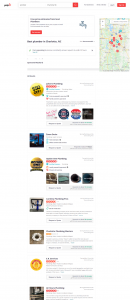
You can use this same technique for other sites like HomeAdvisor, BBB, and Porch.
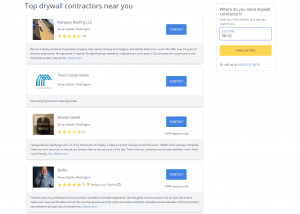
When you’re checking out your top-rated competitors, study their profiles. Find out what offers and deals they are running. How fast is their response time on Yelp? What are their customers saying about them?
During the pandemic, you can also see what they do and how they talk about it to make customers feel safe.
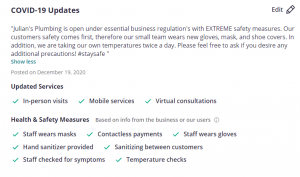
While checking them out, find out what gaps you can fill. Figure out what they’re doing that you’re not offering. See how best you can make your service delivery better.
If their response time is 10 minutes, strive to keep yours in that range. If they offer mobile services, see if you can match that.
If their customers repeatedly commend their after-service manners when they clean up the worksite or offer helpful tips, add those steps to your service delivery process. And do it better.
On the flip side, observe complaints and fill in that gap.
Do people complain about your competitor’s workers refusing to wear masks? Upload a picture of your team talking to customers with their masks on.
Do people complain about how long your competitors take to send a quote? Adjust your CTA on your profile to reflect how quickly you send yours.
Example: “GET A FREE QUOTE IN 30 MINUTES”.
From your assessment of your competitors, you can discover ways to:
- Stand out in a crowded industry
- Make your business the better option for customers
- Deliver a higher quality service that sets your brand apart
- Get more loyal customers who sell your business by word-of-mouth
- Innovate outstanding approaches for service delivery and lead the pack
Leveraging Reviews to Launch More Successful Marketing Campaigns
When marketers in the home business industry run marketing campaigns, there’s usually a problem deciding on the proper positioning, brand messaging, and most effective words.
They often overlook the precious sea of valuable insights already in their lap — customer reviews.
Customer reviews (what they say to you when a job is completed or what’s posted on review sites like Yelp) contain vital info that can build your next campaign.
When you study the reviews customers left you, you can find:
- Who your ideal customer is
- What triggers your ideal customer to look for your services
- The outcome they expect from your services
- Why they chose you over your competitor
- How they felt after you delivered the services
- What would’ve happened if they didn’t work with you
This is information you can get from interviewing your customers. But if you don’t have the budget for that, your reviews are a fine substitute.
To illustrate, let’s check out this review on Yelp for AHWA:
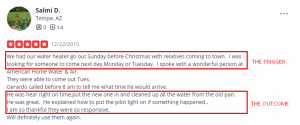
If you go through the reviews for AHWA, you’ll find common themes such as
- Experienced a problem with a water heater
- Needed a solution in 24 hours
- Quick response
- Solved the problem with good housekeeping skills
- Helpful after-service advice
Now, AHWA can see what triggers customers to find their service, the outcomes customers expect, and how customers want the services delivered.
This can also reveal your unique value proposition. Your unique value proposition is the benefit your customers get from your business that isn’t easy to find anywhere else. Some examples include great customer service, most affordable prices, or offering the quickest response time.
This can play out in so many ways. You can use it to
- Write an ad copy: For this review, your ad copy for Yelp can be:
“Get long-lasting solutions to your water heater issues in 24 hours. We will be there right on time and leave the worksite cleaner than we found it. You’ll also get inside tips to ensure your heater doesn’t fail on you again.”
This drives it home for your ideal customer. And as long as everything else on your ad is properly set up, they’ll have a hard time not calling you.
- Create a unifying message for your website content: Careful analysis of your reviews can show you the one thing people attribute to your business. It could be fast response, affordability, great customer service, or trust.
Whatever it is, it can form the basis of your brand messaging and feature in your web content.
See how trust features on this site:
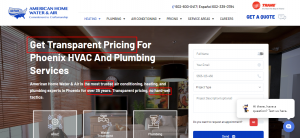
To find your unifying message, you can check the most common words people use when talking about business.
Copy out your most comprehensive 4- and 5-star reviews and add them to a word document.
Paste the content of this document into a free Word cloud generator and check out what you find.
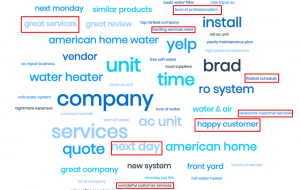
Not only will you find what they say is great about your service. You’ll also see pain points and outcomes they’re scared of. Example: “nightmare expenses” and “hassle”.
Both of these can help you show the reader of your landing page copy what would happen if they don’t contract your service.
It works because it’s authentic and relatable.
- Craft your CTA: The most effective calls-to-action are those that show the reader what they stand to gain if they click a link.
Using the Word cloud we generated here, you can see that the ideal customer is more interested in great customer service and quick response.
Let’s use a quick response for this example. Your CTA could be “GET YOUR WATER HEATER FIXED NOW” or “CALL A TECHNICIAN NOW”.
- Produce a highly effective headline for your landing page: Your landing page headline is the difference between losing 80% of your traffic or convincing them to keep reading.
You’re already winning if you can write a headline that grabs their attention by speaking directly to their needs.
Here’s where your best reviews come in. Using one of the most occurring themes in our illustrations above and leveraging your review counts, your headline for a plumber service landing page can go this way:
“334 People Say We Are the Fastest Responding Plumbing Service in San Francisco.”
Note that this approach will create an objection in their mind, “Oh yeah? Prove it”. And you have to do that in the next couple of lines. But you’ve got their attention.
- Come up with content ideas for your blog: People use Google up to 3 times a day to search for answers to their queries. There is a huge opportunity here to put your brand in front of them when you provide those answers.
This could be in the form of blog posts, videos, or pictures. You can find queries to provide answers to in your reviews.
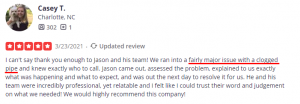
If you notice many of your customers call your plumbing service to fix clogged pipes, you can develop a high-quality comprehensive guide from your experience to share how they can solve the problem.
“Why would I share the solution if I want them to call me to do it and pay me for it?”, you may ask.
Some people may indeed apply the solutions and get results. But most people would choose to call you since you’ve demonstrated with your content that you’re an expert on the subject.
It also puts you in the face of those people who don’t use local directories. And it’s a free way to get extra leads every month.
You can also use reviews to add more credibility and trust to your marketing efforts by featuring them on your landing pages as social proof.
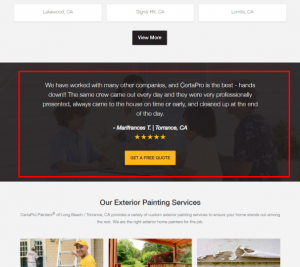
Source: Certa Pro
Of course, all these are only possible if you are listed on your local directory websites and have gathered sufficient reviews over time.
For instance, if you don’t have enough reviews to use the word cloud to get the voice of customer (VoC) insights, it may not be accurate or useful. Aim for a minimum of 25 positive reviews.
26 Business Directory Sites to Get Listed On and Boost Local Exposure
Besides the most popular sites we mentioned in the sections above, there are more than 20 other sites to get listed on and attract more customers in your local area.
In their unique ways, they contribute to your lead generation strategy. Getting listed on these sites also helps you take advantage of the 150% growth in “near me” searches on Google.
Here are 26 of the top local business directory sites for home service businesses:
- Google My Business
- Yelp
- HomeAdvisor
- Angi
- Houzz
- Porch
- Thumbtack
- Bark
- Nextdoor
- Pro Referral
- LinkedIn Company Directory
- Apple Maps Connect
- Yellow Pages
- Bing Places
- Yahoo
- Foursquare
- Facebook for Business
- HotFrog
- Superpages
- MerchantCircle
- Better Business Bureau
- B2B Yellow Pages
- eLocal
- DexKnows
- Alignable
- Local.com
Best practices for listing your company on directory sites
- Use consistent NAP: Your name, address, and phone number have to be the same everywhere you have your business information online. This will help you reap the SEO benefits because Google uses only accurate information to help its users.
- Add a detailed company description: It should describe what you do and how you do it in the shortest way possible. For example, “We are a veteran-owned business that has provided top-quality flooring services in San Diego, CA, for the past 22 years.”
If the entry allows, you can add more information about your services, perks, values, and culture.
- Link to your website: Always add your company URL to your listing. It isn’t enough to have your address and phone number these days. Including your URL gives you backlinks that help your website SEO.
It also appeals to those customers who want to know a little more about your business before hiring you.
- Include multimedia: Wherever possible, add images and videos that show your business in the best possible light. Use high-definition relevant pictures of your services, business operations, and employees.
This looks like a lot of work. That’s why you should keep a spreadsheet of your listings so you can track and update them accordingly. This way you maintain a bird’s eye view of your internet presence on these directories.

Click here to make a copy of a spreadsheet to manage your listing with all these directories already inputted for you.
Key Takeaway
Local directory websites help expose you to people looking for your services online and attract more customers living in your business area.
You can also use them to improve your business by:
- Checking out your competitors to stay one step ahead all the time
- Improve your marketing campaigns and land more customers for your investment
- Show up higher on the results of searches done on Google
These are alternate but highly effective uses of local directory websites that you can start doing right now.
If you know a home business owner or marketer who will enjoy this post, share it with them on Facebook, Twitter, LinkedIn, or Email.
Now it’s your turn: What is one unique way you use local directory websites to grow your home service business?



